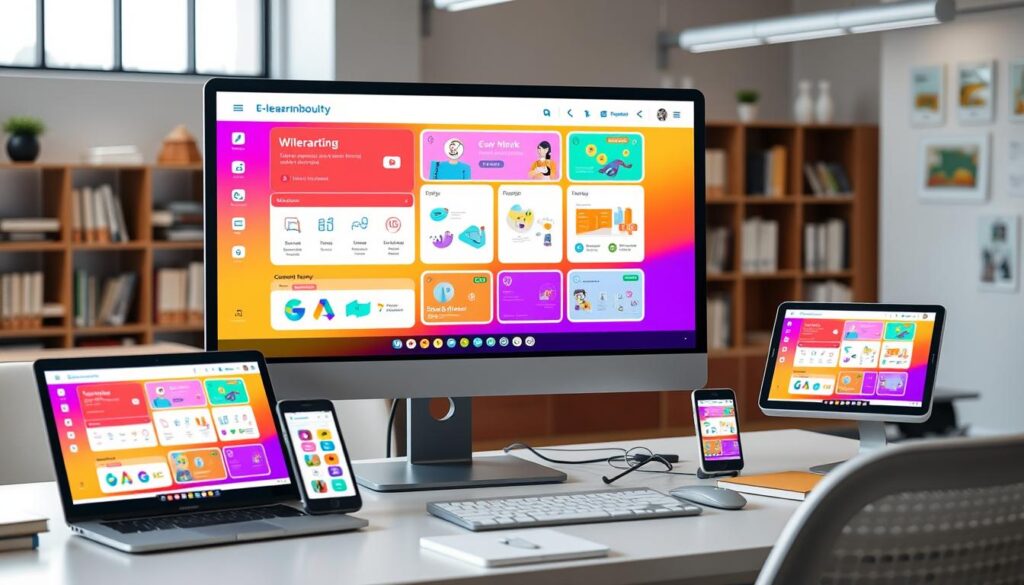Educational technology services are changing the game in online learning. Online course platforms are key to making knowledge available to everyone. They offer top-quality and efficient solutions, breaking barriers of distance and time.
These platforms are not only making learning more accessible. They are transforming how content is developed, shared, and experienced. Features like live sessions and on-demand resources give both teachers and students more flexibility and personalization.
Advanced technologies keep these platforms leading in educational innovation. They are designed to be user-friendly and engaging. This shift isn’t just about turning textbooks into PDFs. It’s about rethinking education to meet today’s fast-paced world.
Key Takeaways
- Central role of online course platforms in modern education
- Advantages of incorporating educational technology services for inclusivity and reach
- Influence of digital learning tools on flexible and personalized education
- The intersection of sophisticated technology with user-centric platform design for optimized learning experiences
- Recognition of e-learning platforms as evolving tools that reflect and adapt to emerging educational trends and preferences
Understanding E-Learning Platforms and Their Importance
The education world has changed a lot because of e-learning software. This software offers strong educational software solutions for different kinds of learners. E-learning platforms bring together various digital tools. Tools like e-learning authoring tools and learning management systems make learning dynamic and personalized.
These platforms help students and teachers connect over long distances. This is done using powerful virtual classroom software.
Definition of E-Learning Platforms
E-learning platforms are advanced online spaces. They help with delivering, managing, and creating educational content. These systems vary from simple document sharing to supporting live interactions and teamwork.
They mark a shift from old-school teaching to digital, easy-to-access, and tailored learning styles.
Key Benefits of E-Learning for Learners and Educators
E-learning platforms benefit both students and teachers in many ways. One main benefit is accessibility, making education available worldwide, no matter where you live or your financial situation. Additionally, the flexibility to learn anytime and anywhere, as long as you have internet, is a major draw.
- Convenience: Users can learn from home, avoiding the hassle of travel.
- Cost-effectiveness: E-learning cuts down on the costs of physical spaces and materials, saving money.
- Customization: Education can be adjusted to fit each person’s learning needs, making it more engaging and memorable.
- Consistency and Quality: E-learning offers a uniform education experience that can reach different areas without losing quality.
E-learning platforms are becoming more popular around the world. Data shows a strong wish among students to keep online learning even after the pandemic ends. This highlights how important these platforms are now and will continue to be in the future of education.
Essential Features of Software Solutions for E-Learning
The global e-learning industry is expected to hit $325 billion by 2025. This growth puts a spotlight on improving online learning platforms. E-learning sites are being crafted to offer knowledge in an engaging, intuitive way. This approach considers each learner’s unique needs and situations.
User-Friendly Interface
An easy-to-understand user interface is critical for an e-learning platform. A clear, intuitive design keeps users interested and helps them move through courses without trouble. For example, platforms like Coursera have better completion rates, thanks to their simple interfaces. These interfaces combine smooth navigation with a design that works for everyone.
Mobile Compatibility
Today, around 3.5 billion people worldwide use smartphones. Plus, 75% of learners like learning on mobile devices. Therefore, e-learning must work well on mobiles. This reality has led to learning platforms that learners can use anywhere, on any device. Moodle and Totara Learn have done a great job, offering mobile-friendly versions just as effective as their desktop sites.
Scalability and Customization
Educational solutions today must be able to grow and change with the needs of institutions and students. Platforms like LearnUpon have scalable options. They provide various training sections for different teams. This flexibility in content and personalized learning journeys helps align educational content with goals and personal learning styles. As a result, it boosts the educational outcomes.
- Interactive modules increase retention and comprehension.
- Analytics drive personalization, improving learner performance through adaptive learning strategies.
- Integration capabilities allow for a broader toolset, augmenting the e-learning environment with tools like Zoom and Slack.
Also, working together with other software systems adds to e-learning platforms’ effectiveness. For example, Cincopa can integrate video heatmaps. This tool provides deep insights on user engagement. Such insights are vital for creating successful learning strategies.
| Feature | Benefits | Examples |
|---|---|---|
| Intuitive Design | Enhances user engagement and course completion rates | Coursera, Docebo |
| Mobile Learning | Supports ubiquitous access, increasing learning opportunities | Moodle, Totara Learn |
| Scalable and Customizable | Meets diverse and evolving educational needs | LearnUpon, Docebo |

Types of E-Learning Software Solutions Available
In today’s education tech world, many e-learning software tools have come up. These tools meet the needs of educators and learners. They help make teaching and learning more efficient and effective.
Learning Management Systems (LMS)
LMS software is key in managing education workflows. It helps schools and colleges automate training administration. It also makes learning processes smoother. These platforms have interactive online classes, track learner performance, and tools for online learning checks. They are vital for both classroom and remote learning.
Virtual Classroom Software
With more remote learning, virtual classroom software is in high demand. This software supports real-time online education. It creates a virtual classroom. This keeps learning interactive. Video calls, live chat, and interactive boards make learning from any place engaging.
Assessment and Evaluation Tools
Assessment tools in e-learning platforms are crucial. They ensure education quality and learning goals are reached. These tools give data to help schools improve their courses. They also help adjust teaching to better fit student needs. Feedback tools are key for teachers to see if their content works well.
Different e-learning software brings varied benefits and functions to improve education. For example, Moodle offers free access but has more features in paid plans. Meanwhile, ClickMeeting is great for virtual classrooms. It has specific tools to make online learning lively and interactive.
| LMS Platform | Subscription Type | Starting Price | Notable Features |
|---|---|---|---|
| iSpring Learn | Business | $6.64 per learner/month | Comprehensive LMS with extensive user management and tracking capabilities |
| Adobe Captivate Prime | Variable | $4 per learner/month | Focuses on interactive learning experiences and extensive media capabilities |
| SAP Litmos | Annual | $5.5 per user/month | Known for its user-friendly interface and integration with multiple systems |
| TalentLMS | Flexible | $59 per user/month | Offers both free and paid plans suited to different sizes of institutions |
| LearnUpon | Monthly | $699 for 50 users | Combines powerful performance tracking with easy-to-use features |
Choosing the right e-learning software can improve e-learning feedback mechanisms. It also makes learning better for students. The goal is to make knowledge sharing effective and fun.
Integrating Multimedia into E-Learning Software
Using multimedia in education changes how teachers teach and students learn. Multimedia in online platforms makes learning content more engaging. This creates immersive learning experiences which are key for better online education.
Importance of Diverse Learning Materials
Multimedia helps meet different learners’ needs through visual, auditory, and kinesthetic styles. It makes learning more inclusive and improves engagement. This leads to better understanding and memory of information in various formats.
Best Practices for Multimedia Integration
It’s crucial to have a good mix of text, visuals, and audio in e-learning. This mix makes the learning space less overwhelming and helps with thinking. Having accessible materials like audio descriptions and captions makes learning more inclusive.
Adding quizzes and simulations makes learning active, boosting engagement and memory. Advances in VR and AR technologies make learning more effective and fun.
Below we explore how multimedia enhances different learning aspects:
| Element | Benefits | Implementation Example |
|---|---|---|
| Visuals & Audio | Improves comprehension and retention | Adobe Captivate for video-based modules |
| Interactive Quizzes | Promotes active learning and retention | H5P for creating dynamic quizzes |
| Virtual Reality | Enhances real-world application of skills | Using VR scenarios to simulate real-life problems |
| Accessibility Features | Ensures inclusivity for all learners | Audio descriptions and transcripts |
| Games & Simulations | Increases engagement and practical learning | Mindsmith for gamified learning experiences |
Incorporating multimedia into e-learning software doesn’t just make learning more interesting. It is also key to the success of educational programs. Using these tools right, educators can build e-learning spaces that are dynamic, engaging, and open to everyone.
Security and Compliance Considerations
Compliance with privacy laws and e-learning data protection are essential today. This is not just about following the law. It’s about creating a secure space for everyone involved. E-learning transaction security is vital for handling sensitive and financial details safely.
Data Privacy Regulations
Data privacy laws like GDPR and CCPA are top priorities for online learning sites. Being compliant keeps user data safe and respects privacy rights. It also stops data leaks. Secure sites ensure learner info, including progress and payment details, is well-protected. They use top-level encryption and regular checks to maintain financial data protection.
Secure Payment Processing
For sites offering special courses, secure payment processing is key. People need to trust the online payment systems they use. By using strong encryption and ensuring e-learning transaction security, sites can guard against online risks and scams. This boosts trust and happiness among users.
Multi-factor authentication (MFA) and secure socket layers (SSL) are vital for safe online transactions.
Schools and course providers should focus on security and legal rules. This protects users and upholds the platform’s reputation as a safe educational space. It also avoids expensive security troubles.
Choosing the Right Software Development Partner
Choosing the right educational software partnership is key for e-learning project success. The increase in digital learning tools use makes the expertise of experienced e-learning developers more important than ever. Know the partner selection criteria and ask the right development process inquiries. This helps you find a partner who fits your tech needs and works well with your team on e-learning project collaboration.

Key Qualifications to Look For
Look for technology expertise and a strong project portfolio in potential partners. It’s important they have a history of creating scalable e-learning solutions for schools and businesses. They should also keep up with the latest in educational technology.
Questions to Ask Potential Partners
Before you choose your e-learning software partner, ask in-depth development process inquiries. Find out about their project management, solution scalability, and post-launch support. Talking about past projects gives you insight into their experience and creativity in e-learning.
| Criteria | Description | Why It Matters |
|---|---|---|
| Technical Expertise | Proficiency in modern technology stacks and e-learning standards. | Ensures the partner can handle complex, scalable e-learning environments. |
| Project Management | Approaches to scheduling, deliverables, and stakeholder communication. | Crucial for keeping projects on track and within budget. |
| Post-Deployment Support | Ongoing maintenance, updates, and customer support services. | Helps guarantee the longevity and evolving relevance of the e-learning solution. |
| Cultural Fit | Alignment of values and work styles between your teams and theirs. | Improves collaboration efficiency and project satisfaction. |
Finding the right software development company means more than making a deal. It’s about building a strategy based on trust, transparency, and understanding. To learn more about making impactful e-learning solutions with the right expertise, check out top e-learning software development services for your education programs.
Measuring the Effectiveness of E-Learning Software
To make sure e-learning solutions are effective, we must use specific success metrics and KPI analysis. These help us see if the e-learning programs meet our education and business goals.
Metrics and KPIs to Consider
Evaluating education outcomes needs a broad approach. We use important indicators and metrics in organizations:
- Completion Rates: This key metric shows the percentage of learners finishing courses. It tells us about their engagement.
- Knowledge Gain: By comparing test scores before and after courses, we see how much learners have learned.
- Skills Improvement: Checking skills before and after training shows us how much learners have improved.
- Learner Satisfaction: We collect feedback to understand how happy learners are. This impacts their motivation and choices for future courses.
Collecting and Analyzing Feedback
Feedback is key to improving online courses. Organizations use learners’ opinions to make courses better. They get feedback through surveys, forums, and interviews.
Here’s how they use different methods:
| Feedback Method | Utilization | Impact |
|---|---|---|
| Surveys | Frequently used post-course | Gauge satisfaction and identify gaps |
| Discussion Forums | Continuous during course delivery | Encourage engagement and provide real-time insights |
| Direct Interviews | Selected cases post-training | Deep dive into user experience and outcomes |
By analyzing this feedback in real-time, we can make our e-learning platforms better and more relevant.
Future Trends in E-Learning Software Solutions
The way we learn is changing fast, thanks to technology. Innovations like AI in e-learning and machine learning applications are starting a new chapter for online learning. The e-learning market was worth $399.3 billion in 2022. Experts believe it will reach one Trillion by 2032. This growth shows that adaptive learning technologies are leading the way in education.
AI and Machine Learning Innovations
Artificial Intelligence and Machine Learning are transforming education. They sort through lots of data to create custom e-learning paths. These paths adjust to the way each person learns. AI has made students 63% more engaged in learning. Also, using AI, students can learn four times faster with VR-based programs than with old methods.
Enhanced Personalization Techniques
Now, digital platforms offer learning that fits each student. Learning in ways that suit each person is becoming important. With adaptive learning technologies, everyone’s learning journey is unique. This approach ensures better results and more interest in the lessons.
The future of e-learning will also involve AR and VR technologies. These could make the e-learning market worth $142 billion by 2031. Learning with AR and VR makes education more impactful, boosting motivation and understanding.


